University Assignment: Managing Innovation and Technology Transfer
VerifiedAdded on 2019/12/28
|12
|3475
|273
Report
AI Summary
This report delves into the critical aspects of managing innovation and technology transfer, emphasizing the need for organizations to cultivate a culture of innovation to remain competitive. It begins with an introduction highlighting the importance of innovation in today's dynamic business environment, followed by an analytical approach that examines various methods for managing innovation, such as product life cycle, product line planning, and supply chain management. The report uses Nisa retail as a case study, focusing on the significance of supply chain management for retail innovation. It explores methodologies for optimizing supply chains, including inventory planning, product transition, and point-of-sale processes. The study also discusses the critical role of technology, such as RFID and ERP systems, in enhancing supply chain efficiency. The conclusion emphasizes that innovation should align with business strategies and offers solutions for successful implementation, including staff engagement, clear communication, and process improvement. The critical evaluation assesses the risks and strategic approaches necessary for building an innovative organization.
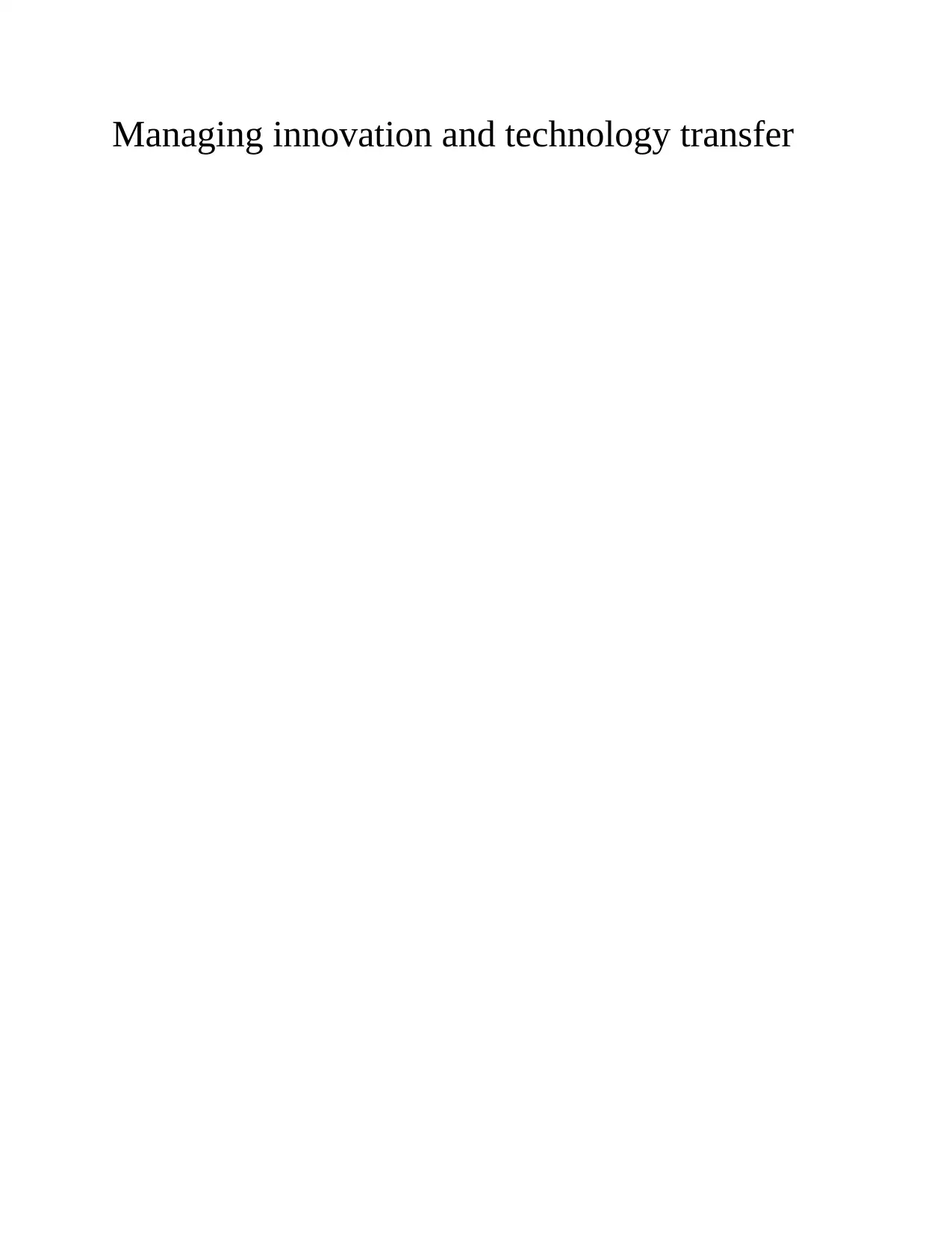
Managing innovation and technology transfer
Paraphrase This Document
Need a fresh take? Get an instant paraphrase of this document with our AI Paraphraser
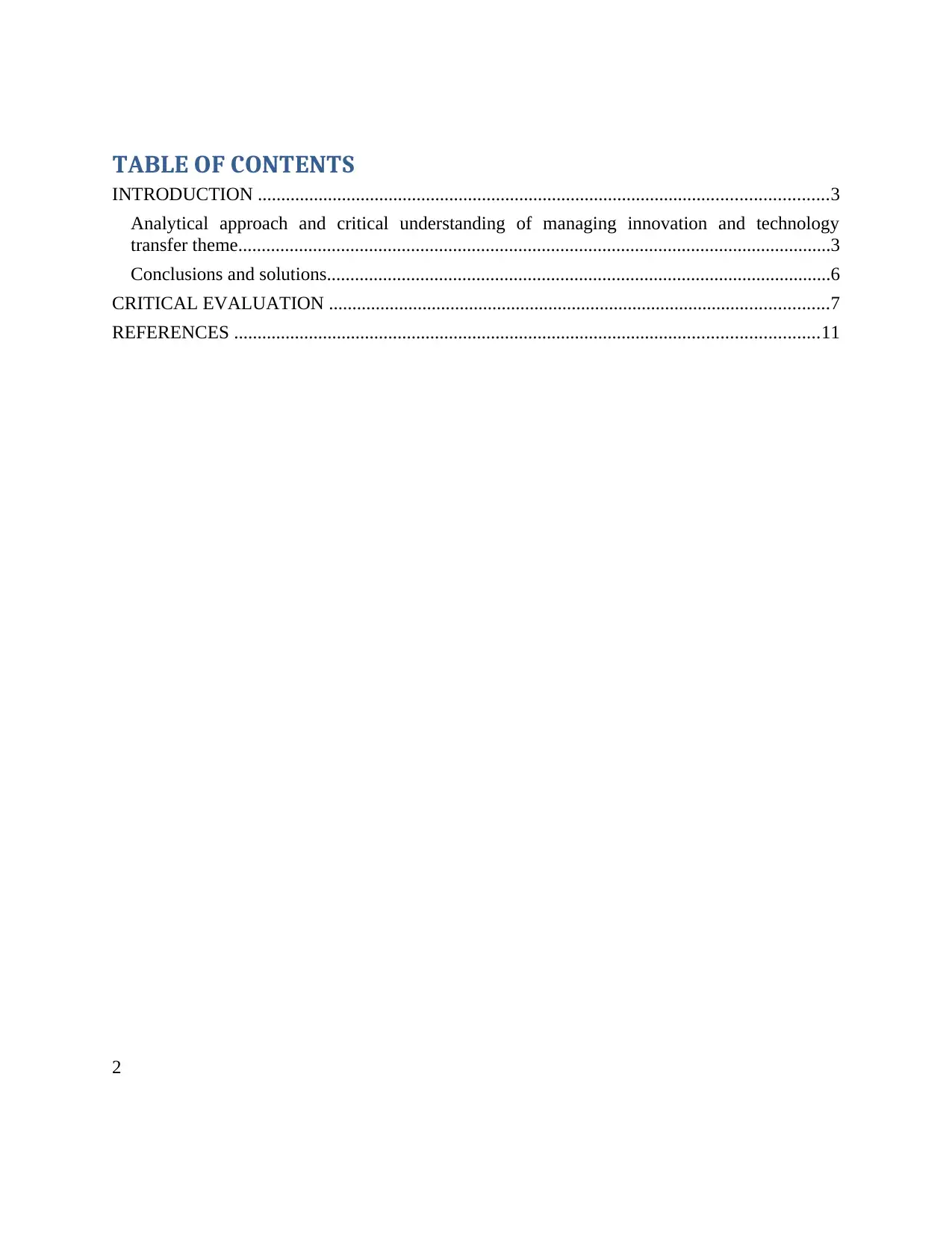
TABLE OF CONTENTS
INTRODUCTION ..........................................................................................................................3
Analytical approach and critical understanding of managing innovation and technology
transfer theme...............................................................................................................................3
Conclusions and solutions............................................................................................................6
CRITICAL EVALUATION ...........................................................................................................7
REFERENCES .............................................................................................................................11
2
INTRODUCTION ..........................................................................................................................3
Analytical approach and critical understanding of managing innovation and technology
transfer theme...............................................................................................................................3
Conclusions and solutions............................................................................................................6
CRITICAL EVALUATION ...........................................................................................................7
REFERENCES .............................................................................................................................11
2
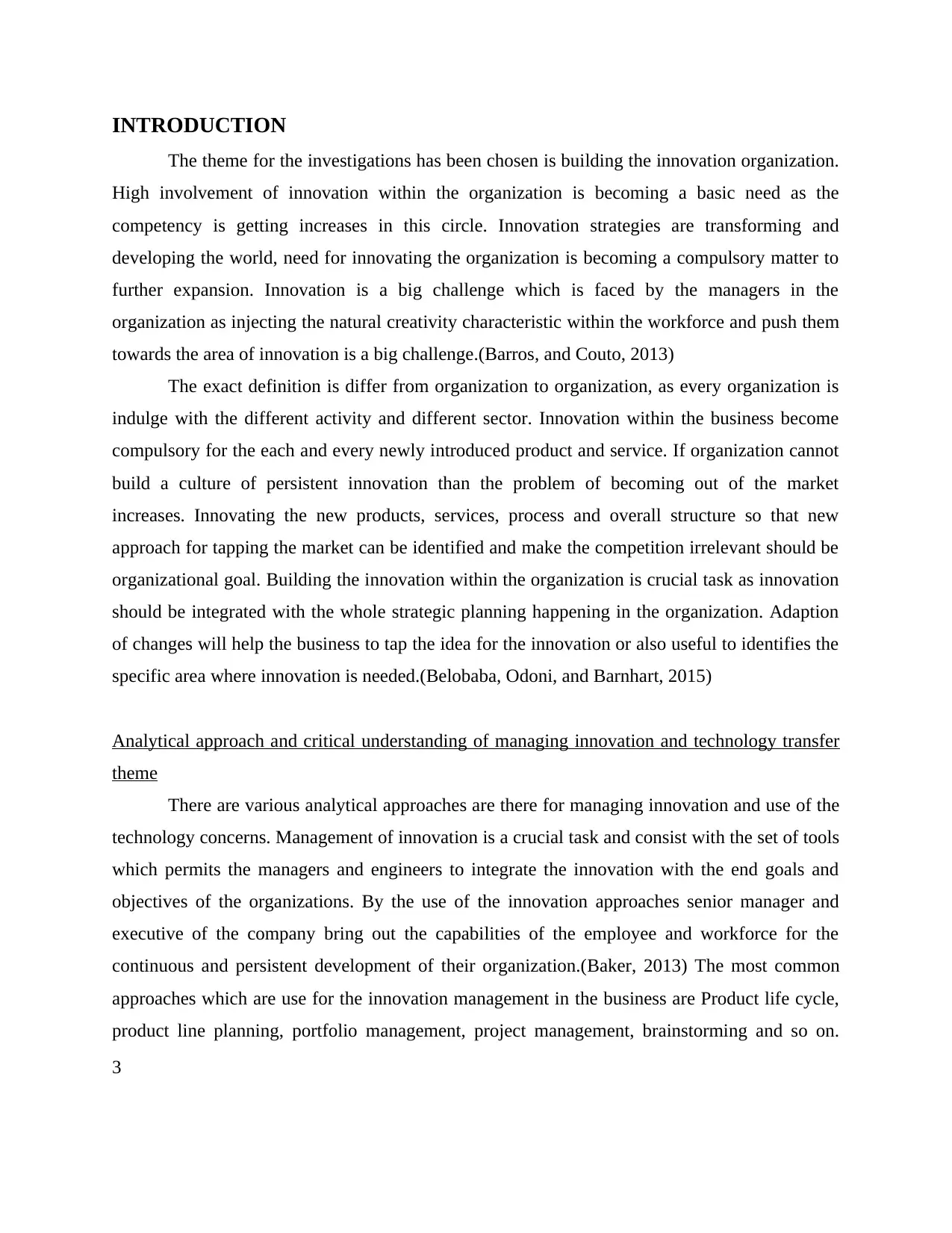
INTRODUCTION
The theme for the investigations has been chosen is building the innovation organization.
High involvement of innovation within the organization is becoming a basic need as the
competency is getting increases in this circle. Innovation strategies are transforming and
developing the world, need for innovating the organization is becoming a compulsory matter to
further expansion. Innovation is a big challenge which is faced by the managers in the
organization as injecting the natural creativity characteristic within the workforce and push them
towards the area of innovation is a big challenge.(Barros, and Couto, 2013)
The exact definition is differ from organization to organization, as every organization is
indulge with the different activity and different sector. Innovation within the business become
compulsory for the each and every newly introduced product and service. If organization cannot
build a culture of persistent innovation than the problem of becoming out of the market
increases. Innovating the new products, services, process and overall structure so that new
approach for tapping the market can be identified and make the competition irrelevant should be
organizational goal. Building the innovation within the organization is crucial task as innovation
should be integrated with the whole strategic planning happening in the organization. Adaption
of changes will help the business to tap the idea for the innovation or also useful to identifies the
specific area where innovation is needed.(Belobaba, Odoni, and Barnhart, 2015)
Analytical approach and critical understanding of managing innovation and technology transfer
theme
There are various analytical approaches are there for managing innovation and use of the
technology concerns. Management of innovation is a crucial task and consist with the set of tools
which permits the managers and engineers to integrate the innovation with the end goals and
objectives of the organizations. By the use of the innovation approaches senior manager and
executive of the company bring out the capabilities of the employee and workforce for the
continuous and persistent development of their organization.(Baker, 2013) The most common
approaches which are use for the innovation management in the business are Product life cycle,
product line planning, portfolio management, project management, brainstorming and so on.
3
The theme for the investigations has been chosen is building the innovation organization.
High involvement of innovation within the organization is becoming a basic need as the
competency is getting increases in this circle. Innovation strategies are transforming and
developing the world, need for innovating the organization is becoming a compulsory matter to
further expansion. Innovation is a big challenge which is faced by the managers in the
organization as injecting the natural creativity characteristic within the workforce and push them
towards the area of innovation is a big challenge.(Barros, and Couto, 2013)
The exact definition is differ from organization to organization, as every organization is
indulge with the different activity and different sector. Innovation within the business become
compulsory for the each and every newly introduced product and service. If organization cannot
build a culture of persistent innovation than the problem of becoming out of the market
increases. Innovating the new products, services, process and overall structure so that new
approach for tapping the market can be identified and make the competition irrelevant should be
organizational goal. Building the innovation within the organization is crucial task as innovation
should be integrated with the whole strategic planning happening in the organization. Adaption
of changes will help the business to tap the idea for the innovation or also useful to identifies the
specific area where innovation is needed.(Belobaba, Odoni, and Barnhart, 2015)
Analytical approach and critical understanding of managing innovation and technology transfer
theme
There are various analytical approaches are there for managing innovation and use of the
technology concerns. Management of innovation is a crucial task and consist with the set of tools
which permits the managers and engineers to integrate the innovation with the end goals and
objectives of the organizations. By the use of the innovation approaches senior manager and
executive of the company bring out the capabilities of the employee and workforce for the
continuous and persistent development of their organization.(Baker, 2013) The most common
approaches which are use for the innovation management in the business are Product life cycle,
product line planning, portfolio management, project management, brainstorming and so on.
3
⊘ This is a preview!⊘
Do you want full access?
Subscribe today to unlock all pages.

Trusted by 1+ million students worldwide
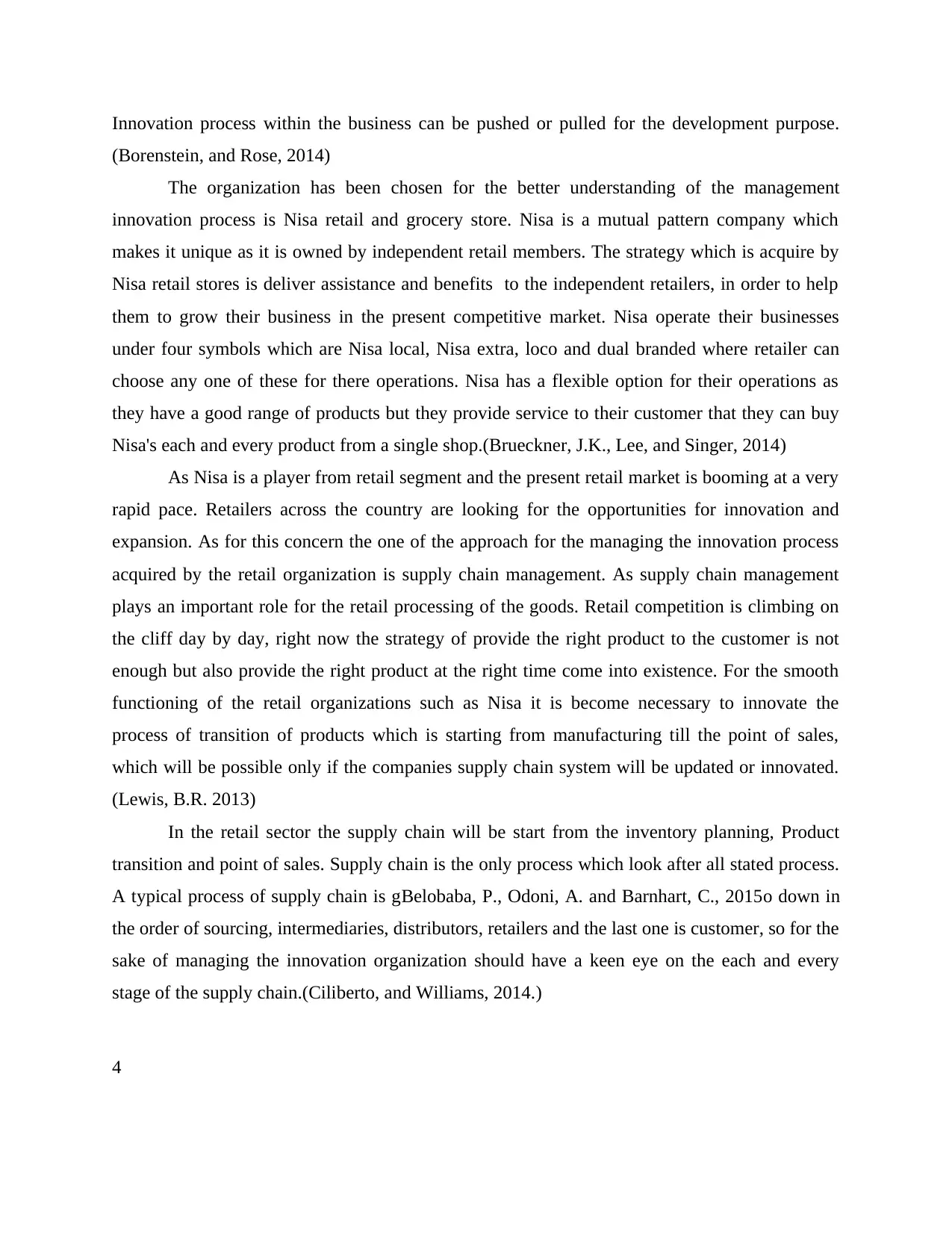
Innovation process within the business can be pushed or pulled for the development purpose.
(Borenstein, and Rose, 2014)
The organization has been chosen for the better understanding of the management
innovation process is Nisa retail and grocery store. Nisa is a mutual pattern company which
makes it unique as it is owned by independent retail members. The strategy which is acquire by
Nisa retail stores is deliver assistance and benefits to the independent retailers, in order to help
them to grow their business in the present competitive market. Nisa operate their businesses
under four symbols which are Nisa local, Nisa extra, loco and dual branded where retailer can
choose any one of these for there operations. Nisa has a flexible option for their operations as
they have a good range of products but they provide service to their customer that they can buy
Nisa's each and every product from a single shop.(Brueckner, J.K., Lee, and Singer, 2014)
As Nisa is a player from retail segment and the present retail market is booming at a very
rapid pace. Retailers across the country are looking for the opportunities for innovation and
expansion. As for this concern the one of the approach for the managing the innovation process
acquired by the retail organization is supply chain management. As supply chain management
plays an important role for the retail processing of the goods. Retail competition is climbing on
the cliff day by day, right now the strategy of provide the right product to the customer is not
enough but also provide the right product at the right time come into existence. For the smooth
functioning of the retail organizations such as Nisa it is become necessary to innovate the
process of transition of products which is starting from manufacturing till the point of sales,
which will be possible only if the companies supply chain system will be updated or innovated.
(Lewis, B.R. 2013)
In the retail sector the supply chain will be start from the inventory planning, Product
transition and point of sales. Supply chain is the only process which look after all stated process.
A typical process of supply chain is gBelobaba, P., Odoni, A. and Barnhart, C., 2015o down in
the order of sourcing, intermediaries, distributors, retailers and the last one is customer, so for the
sake of managing the innovation organization should have a keen eye on the each and every
stage of the supply chain.(Ciliberto, and Williams, 2014.)
4
(Borenstein, and Rose, 2014)
The organization has been chosen for the better understanding of the management
innovation process is Nisa retail and grocery store. Nisa is a mutual pattern company which
makes it unique as it is owned by independent retail members. The strategy which is acquire by
Nisa retail stores is deliver assistance and benefits to the independent retailers, in order to help
them to grow their business in the present competitive market. Nisa operate their businesses
under four symbols which are Nisa local, Nisa extra, loco and dual branded where retailer can
choose any one of these for there operations. Nisa has a flexible option for their operations as
they have a good range of products but they provide service to their customer that they can buy
Nisa's each and every product from a single shop.(Brueckner, J.K., Lee, and Singer, 2014)
As Nisa is a player from retail segment and the present retail market is booming at a very
rapid pace. Retailers across the country are looking for the opportunities for innovation and
expansion. As for this concern the one of the approach for the managing the innovation process
acquired by the retail organization is supply chain management. As supply chain management
plays an important role for the retail processing of the goods. Retail competition is climbing on
the cliff day by day, right now the strategy of provide the right product to the customer is not
enough but also provide the right product at the right time come into existence. For the smooth
functioning of the retail organizations such as Nisa it is become necessary to innovate the
process of transition of products which is starting from manufacturing till the point of sales,
which will be possible only if the companies supply chain system will be updated or innovated.
(Lewis, B.R. 2013)
In the retail sector the supply chain will be start from the inventory planning, Product
transition and point of sales. Supply chain is the only process which look after all stated process.
A typical process of supply chain is gBelobaba, P., Odoni, A. and Barnhart, C., 2015o down in
the order of sourcing, intermediaries, distributors, retailers and the last one is customer, so for the
sake of managing the innovation organization should have a keen eye on the each and every
stage of the supply chain.(Ciliberto, and Williams, 2014.)
4
Paraphrase This Document
Need a fresh take? Get an instant paraphrase of this document with our AI Paraphraser
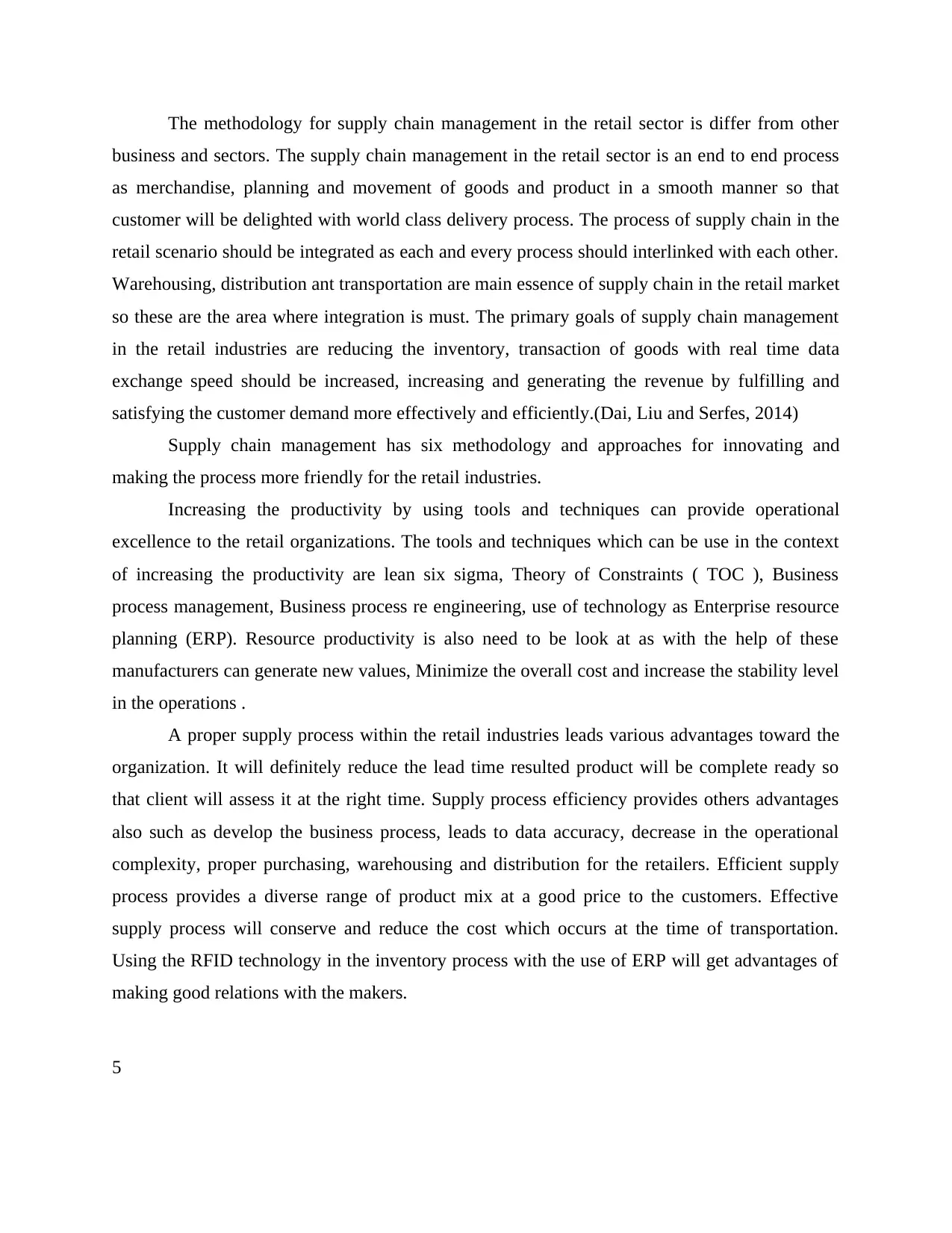
The methodology for supply chain management in the retail sector is differ from other
business and sectors. The supply chain management in the retail sector is an end to end process
as merchandise, planning and movement of goods and product in a smooth manner so that
customer will be delighted with world class delivery process. The process of supply chain in the
retail scenario should be integrated as each and every process should interlinked with each other.
Warehousing, distribution ant transportation are main essence of supply chain in the retail market
so these are the area where integration is must. The primary goals of supply chain management
in the retail industries are reducing the inventory, transaction of goods with real time data
exchange speed should be increased, increasing and generating the revenue by fulfilling and
satisfying the customer demand more effectively and efficiently.(Dai, Liu and Serfes, 2014)
Supply chain management has six methodology and approaches for innovating and
making the process more friendly for the retail industries.
Increasing the productivity by using tools and techniques can provide operational
excellence to the retail organizations. The tools and techniques which can be use in the context
of increasing the productivity are lean six sigma, Theory of Constraints ( TOC ), Business
process management, Business process re engineering, use of technology as Enterprise resource
planning (ERP). Resource productivity is also need to be look at as with the help of these
manufacturers can generate new values, Minimize the overall cost and increase the stability level
in the operations .
A proper supply process within the retail industries leads various advantages toward the
organization. It will definitely reduce the lead time resulted product will be complete ready so
that client will assess it at the right time. Supply process efficiency provides others advantages
also such as develop the business process, leads to data accuracy, decrease in the operational
complexity, proper purchasing, warehousing and distribution for the retailers. Efficient supply
process provides a diverse range of product mix at a good price to the customers. Effective
supply process will conserve and reduce the cost which occurs at the time of transportation.
Using the RFID technology in the inventory process with the use of ERP will get advantages of
making good relations with the makers.
5
business and sectors. The supply chain management in the retail sector is an end to end process
as merchandise, planning and movement of goods and product in a smooth manner so that
customer will be delighted with world class delivery process. The process of supply chain in the
retail scenario should be integrated as each and every process should interlinked with each other.
Warehousing, distribution ant transportation are main essence of supply chain in the retail market
so these are the area where integration is must. The primary goals of supply chain management
in the retail industries are reducing the inventory, transaction of goods with real time data
exchange speed should be increased, increasing and generating the revenue by fulfilling and
satisfying the customer demand more effectively and efficiently.(Dai, Liu and Serfes, 2014)
Supply chain management has six methodology and approaches for innovating and
making the process more friendly for the retail industries.
Increasing the productivity by using tools and techniques can provide operational
excellence to the retail organizations. The tools and techniques which can be use in the context
of increasing the productivity are lean six sigma, Theory of Constraints ( TOC ), Business
process management, Business process re engineering, use of technology as Enterprise resource
planning (ERP). Resource productivity is also need to be look at as with the help of these
manufacturers can generate new values, Minimize the overall cost and increase the stability level
in the operations .
A proper supply process within the retail industries leads various advantages toward the
organization. It will definitely reduce the lead time resulted product will be complete ready so
that client will assess it at the right time. Supply process efficiency provides others advantages
also such as develop the business process, leads to data accuracy, decrease in the operational
complexity, proper purchasing, warehousing and distribution for the retailers. Efficient supply
process provides a diverse range of product mix at a good price to the customers. Effective
supply process will conserve and reduce the cost which occurs at the time of transportation.
Using the RFID technology in the inventory process with the use of ERP will get advantages of
making good relations with the makers.
5
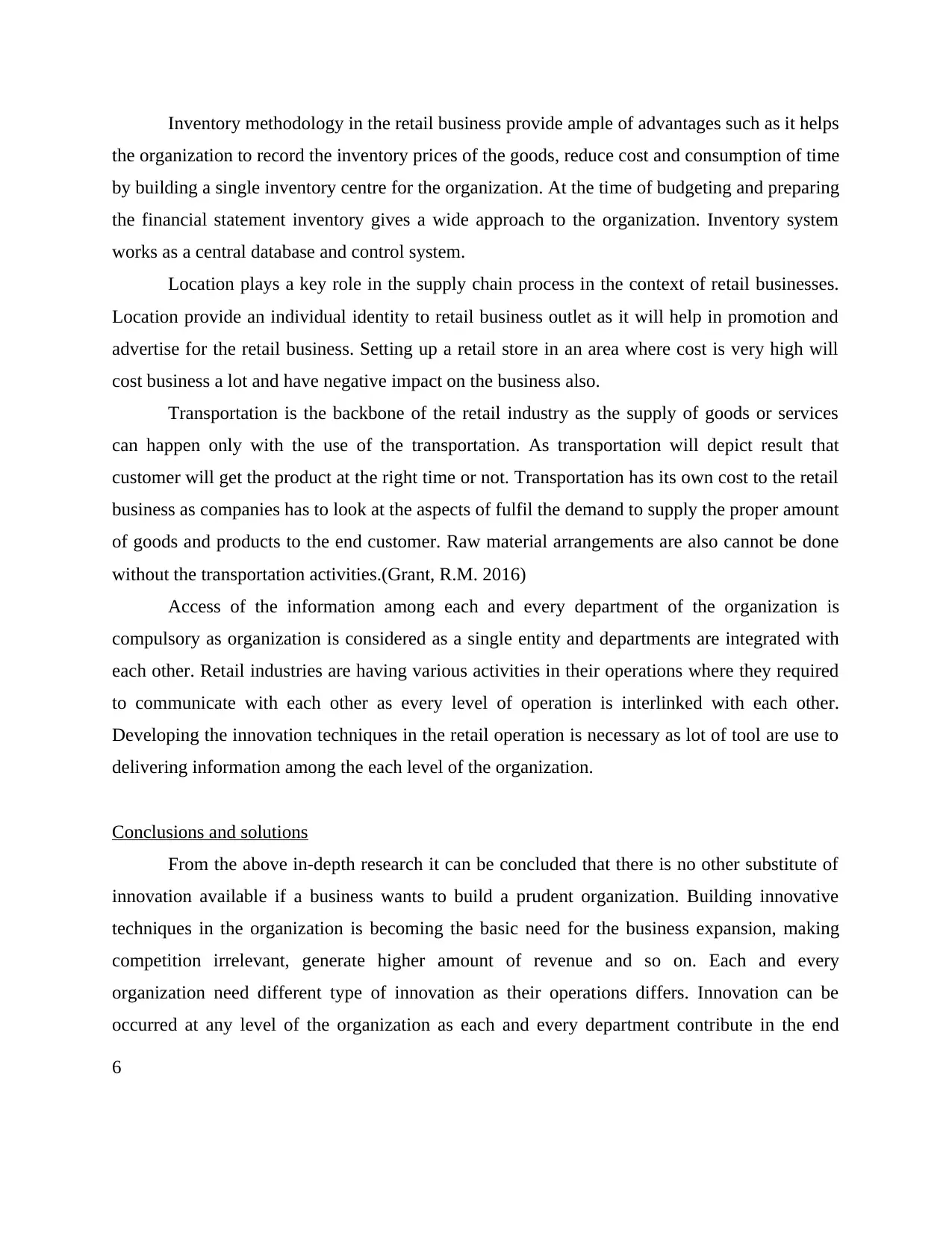
Inventory methodology in the retail business provide ample of advantages such as it helps
the organization to record the inventory prices of the goods, reduce cost and consumption of time
by building a single inventory centre for the organization. At the time of budgeting and preparing
the financial statement inventory gives a wide approach to the organization. Inventory system
works as a central database and control system.
Location plays a key role in the supply chain process in the context of retail businesses.
Location provide an individual identity to retail business outlet as it will help in promotion and
advertise for the retail business. Setting up a retail store in an area where cost is very high will
cost business a lot and have negative impact on the business also.
Transportation is the backbone of the retail industry as the supply of goods or services
can happen only with the use of the transportation. As transportation will depict result that
customer will get the product at the right time or not. Transportation has its own cost to the retail
business as companies has to look at the aspects of fulfil the demand to supply the proper amount
of goods and products to the end customer. Raw material arrangements are also cannot be done
without the transportation activities.(Grant, R.M. 2016)
Access of the information among each and every department of the organization is
compulsory as organization is considered as a single entity and departments are integrated with
each other. Retail industries are having various activities in their operations where they required
to communicate with each other as every level of operation is interlinked with each other.
Developing the innovation techniques in the retail operation is necessary as lot of tool are use to
delivering information among the each level of the organization.
Conclusions and solutions
From the above in-depth research it can be concluded that there is no other substitute of
innovation available if a business wants to build a prudent organization. Building innovative
techniques in the organization is becoming the basic need for the business expansion, making
competition irrelevant, generate higher amount of revenue and so on. Each and every
organization need different type of innovation as their operations differs. Innovation can be
occurred at any level of the organization as each and every department contribute in the end
6
the organization to record the inventory prices of the goods, reduce cost and consumption of time
by building a single inventory centre for the organization. At the time of budgeting and preparing
the financial statement inventory gives a wide approach to the organization. Inventory system
works as a central database and control system.
Location plays a key role in the supply chain process in the context of retail businesses.
Location provide an individual identity to retail business outlet as it will help in promotion and
advertise for the retail business. Setting up a retail store in an area where cost is very high will
cost business a lot and have negative impact on the business also.
Transportation is the backbone of the retail industry as the supply of goods or services
can happen only with the use of the transportation. As transportation will depict result that
customer will get the product at the right time or not. Transportation has its own cost to the retail
business as companies has to look at the aspects of fulfil the demand to supply the proper amount
of goods and products to the end customer. Raw material arrangements are also cannot be done
without the transportation activities.(Grant, R.M. 2016)
Access of the information among each and every department of the organization is
compulsory as organization is considered as a single entity and departments are integrated with
each other. Retail industries are having various activities in their operations where they required
to communicate with each other as every level of operation is interlinked with each other.
Developing the innovation techniques in the retail operation is necessary as lot of tool are use to
delivering information among the each level of the organization.
Conclusions and solutions
From the above in-depth research it can be concluded that there is no other substitute of
innovation available if a business wants to build a prudent organization. Building innovative
techniques in the organization is becoming the basic need for the business expansion, making
competition irrelevant, generate higher amount of revenue and so on. Each and every
organization need different type of innovation as their operations differs. Innovation can be
occurred at any level of the organization as each and every department contribute in the end
6
⊘ This is a preview!⊘
Do you want full access?
Subscribe today to unlock all pages.

Trusted by 1+ million students worldwide
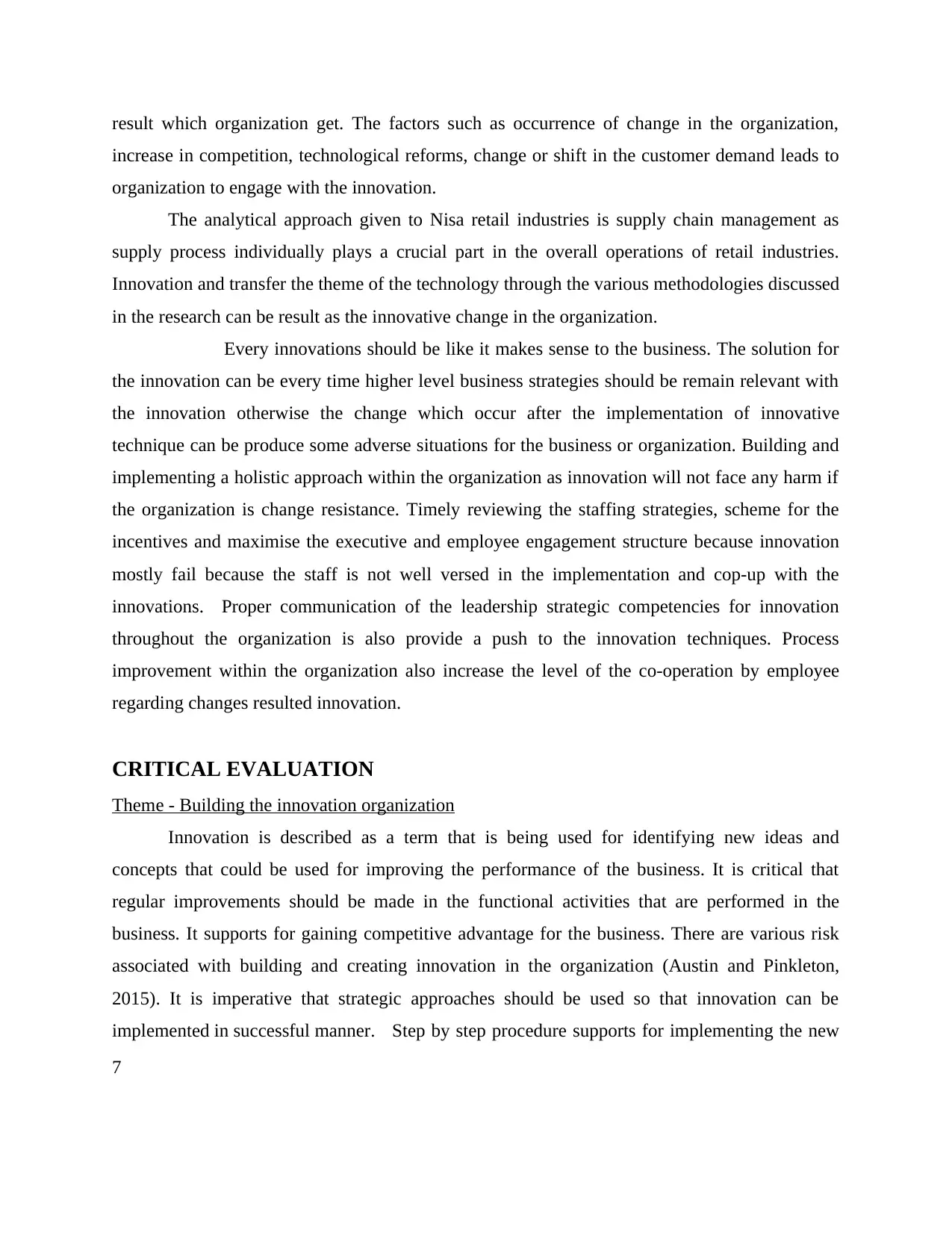
result which organization get. The factors such as occurrence of change in the organization,
increase in competition, technological reforms, change or shift in the customer demand leads to
organization to engage with the innovation.
The analytical approach given to Nisa retail industries is supply chain management as
supply process individually plays a crucial part in the overall operations of retail industries.
Innovation and transfer the theme of the technology through the various methodologies discussed
in the research can be result as the innovative change in the organization.
Every innovations should be like it makes sense to the business. The solution for
the innovation can be every time higher level business strategies should be remain relevant with
the innovation otherwise the change which occur after the implementation of innovative
technique can be produce some adverse situations for the business or organization. Building and
implementing a holistic approach within the organization as innovation will not face any harm if
the organization is change resistance. Timely reviewing the staffing strategies, scheme for the
incentives and maximise the executive and employee engagement structure because innovation
mostly fail because the staff is not well versed in the implementation and cop-up with the
innovations. Proper communication of the leadership strategic competencies for innovation
throughout the organization is also provide a push to the innovation techniques. Process
improvement within the organization also increase the level of the co-operation by employee
regarding changes resulted innovation.
CRITICAL EVALUATION
Theme - Building the innovation organization
Innovation is described as a term that is being used for identifying new ideas and
concepts that could be used for improving the performance of the business. It is critical that
regular improvements should be made in the functional activities that are performed in the
business. It supports for gaining competitive advantage for the business. There are various risk
associated with building and creating innovation in the organization (Austin and Pinkleton,
2015). It is imperative that strategic approaches should be used so that innovation can be
implemented in successful manner. Step by step procedure supports for implementing the new
7
increase in competition, technological reforms, change or shift in the customer demand leads to
organization to engage with the innovation.
The analytical approach given to Nisa retail industries is supply chain management as
supply process individually plays a crucial part in the overall operations of retail industries.
Innovation and transfer the theme of the technology through the various methodologies discussed
in the research can be result as the innovative change in the organization.
Every innovations should be like it makes sense to the business. The solution for
the innovation can be every time higher level business strategies should be remain relevant with
the innovation otherwise the change which occur after the implementation of innovative
technique can be produce some adverse situations for the business or organization. Building and
implementing a holistic approach within the organization as innovation will not face any harm if
the organization is change resistance. Timely reviewing the staffing strategies, scheme for the
incentives and maximise the executive and employee engagement structure because innovation
mostly fail because the staff is not well versed in the implementation and cop-up with the
innovations. Proper communication of the leadership strategic competencies for innovation
throughout the organization is also provide a push to the innovation techniques. Process
improvement within the organization also increase the level of the co-operation by employee
regarding changes resulted innovation.
CRITICAL EVALUATION
Theme - Building the innovation organization
Innovation is described as a term that is being used for identifying new ideas and
concepts that could be used for improving the performance of the business. It is critical that
regular improvements should be made in the functional activities that are performed in the
business. It supports for gaining competitive advantage for the business. There are various risk
associated with building and creating innovation in the organization (Austin and Pinkleton,
2015). It is imperative that strategic approaches should be used so that innovation can be
implemented in successful manner. Step by step procedure supports for implementing the new
7
Paraphrase This Document
Need a fresh take? Get an instant paraphrase of this document with our AI Paraphraser
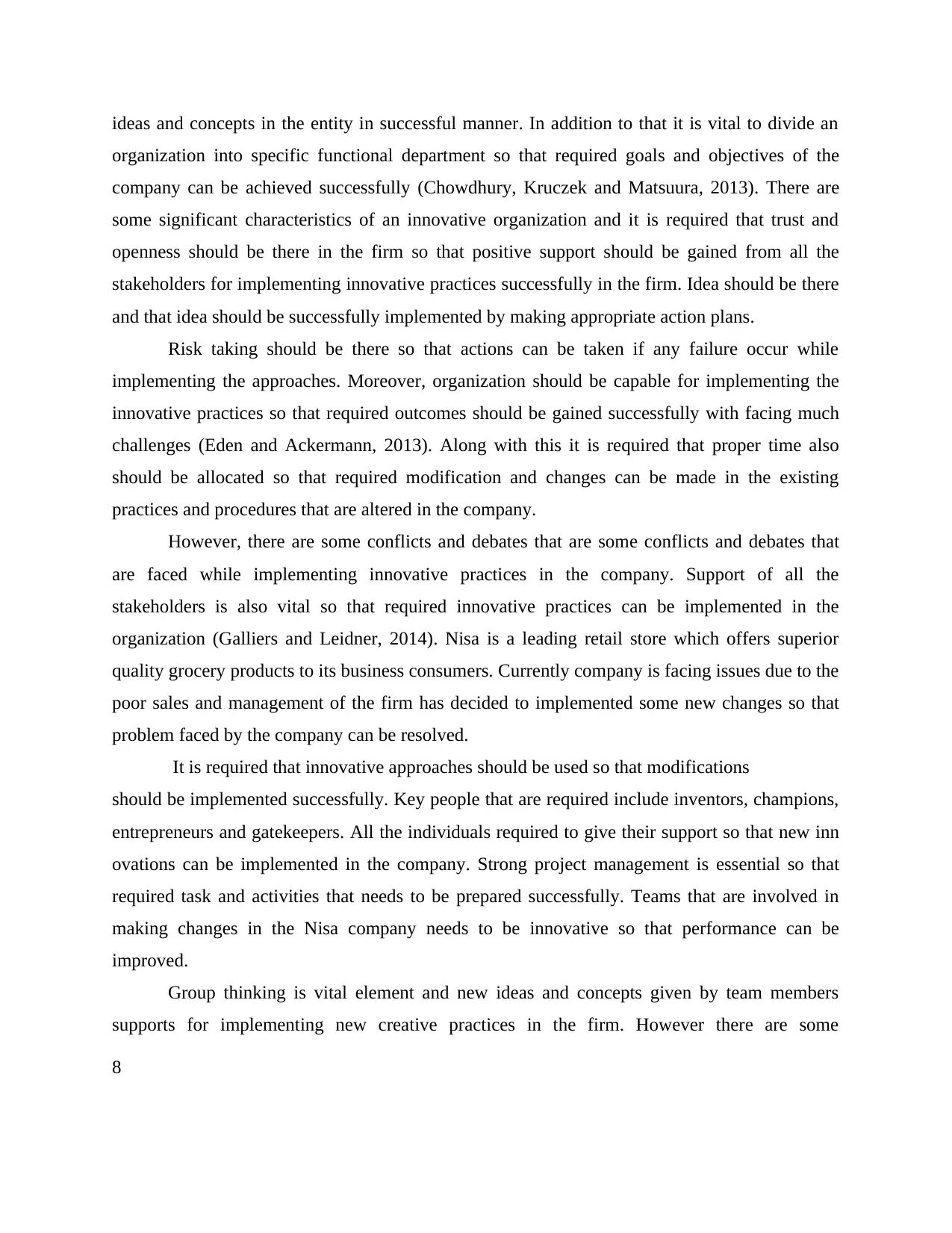
ideas and concepts in the entity in successful manner. In addition to that it is vital to divide an
organization into specific functional department so that required goals and objectives of the
company can be achieved successfully (Chowdhury, Kruczek and Matsuura, 2013). There are
some significant characteristics of an innovative organization and it is required that trust and
openness should be there in the firm so that positive support should be gained from all the
stakeholders for implementing innovative practices successfully in the firm. Idea should be there
and that idea should be successfully implemented by making appropriate action plans.
Risk taking should be there so that actions can be taken if any failure occur while
implementing the approaches. Moreover, organization should be capable for implementing the
innovative practices so that required outcomes should be gained successfully with facing much
challenges (Eden and Ackermann, 2013). Along with this it is required that proper time also
should be allocated so that required modification and changes can be made in the existing
practices and procedures that are altered in the company.
However, there are some conflicts and debates that are some conflicts and debates that
are faced while implementing innovative practices in the company. Support of all the
stakeholders is also vital so that required innovative practices can be implemented in the
organization (Galliers and Leidner, 2014). Nisa is a leading retail store which offers superior
quality grocery products to its business consumers. Currently company is facing issues due to the
poor sales and management of the firm has decided to implemented some new changes so that
problem faced by the company can be resolved.
It is required that innovative approaches should be used so that modifications
should be implemented successfully. Key people that are required include inventors, champions,
entrepreneurs and gatekeepers. All the individuals required to give their support so that new inn
ovations can be implemented in the company. Strong project management is essential so that
required task and activities that needs to be prepared successfully. Teams that are involved in
making changes in the Nisa company needs to be innovative so that performance can be
improved.
Group thinking is vital element and new ideas and concepts given by team members
supports for implementing new creative practices in the firm. However there are some
8
organization into specific functional department so that required goals and objectives of the
company can be achieved successfully (Chowdhury, Kruczek and Matsuura, 2013). There are
some significant characteristics of an innovative organization and it is required that trust and
openness should be there in the firm so that positive support should be gained from all the
stakeholders for implementing innovative practices successfully in the firm. Idea should be there
and that idea should be successfully implemented by making appropriate action plans.
Risk taking should be there so that actions can be taken if any failure occur while
implementing the approaches. Moreover, organization should be capable for implementing the
innovative practices so that required outcomes should be gained successfully with facing much
challenges (Eden and Ackermann, 2013). Along with this it is required that proper time also
should be allocated so that required modification and changes can be made in the existing
practices and procedures that are altered in the company.
However, there are some conflicts and debates that are some conflicts and debates that
are faced while implementing innovative practices in the company. Support of all the
stakeholders is also vital so that required innovative practices can be implemented in the
organization (Galliers and Leidner, 2014). Nisa is a leading retail store which offers superior
quality grocery products to its business consumers. Currently company is facing issues due to the
poor sales and management of the firm has decided to implemented some new changes so that
problem faced by the company can be resolved.
It is required that innovative approaches should be used so that modifications
should be implemented successfully. Key people that are required include inventors, champions,
entrepreneurs and gatekeepers. All the individuals required to give their support so that new inn
ovations can be implemented in the company. Strong project management is essential so that
required task and activities that needs to be prepared successfully. Teams that are involved in
making changes in the Nisa company needs to be innovative so that performance can be
improved.
Group thinking is vital element and new ideas and concepts given by team members
supports for implementing new creative practices in the firm. However there are some
8
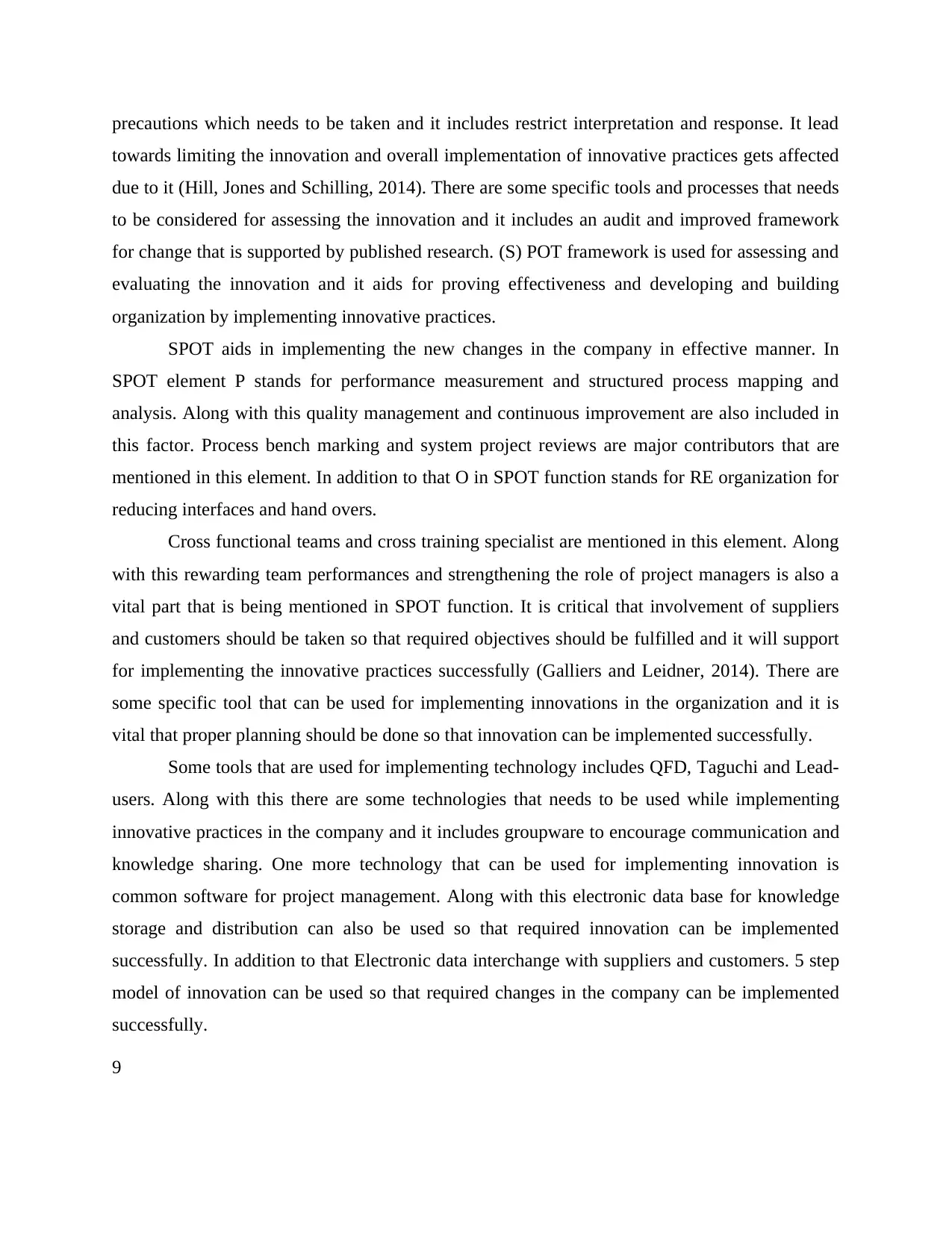
precautions which needs to be taken and it includes restrict interpretation and response. It lead
towards limiting the innovation and overall implementation of innovative practices gets affected
due to it (Hill, Jones and Schilling, 2014). There are some specific tools and processes that needs
to be considered for assessing the innovation and it includes an audit and improved framework
for change that is supported by published research. (S) POT framework is used for assessing and
evaluating the innovation and it aids for proving effectiveness and developing and building
organization by implementing innovative practices.
SPOT aids in implementing the new changes in the company in effective manner. In
SPOT element P stands for performance measurement and structured process mapping and
analysis. Along with this quality management and continuous improvement are also included in
this factor. Process bench marking and system project reviews are major contributors that are
mentioned in this element. In addition to that O in SPOT function stands for RE organization for
reducing interfaces and hand overs.
Cross functional teams and cross training specialist are mentioned in this element. Along
with this rewarding team performances and strengthening the role of project managers is also a
vital part that is being mentioned in SPOT function. It is critical that involvement of suppliers
and customers should be taken so that required objectives should be fulfilled and it will support
for implementing the innovative practices successfully (Galliers and Leidner, 2014). There are
some specific tool that can be used for implementing innovations in the organization and it is
vital that proper planning should be done so that innovation can be implemented successfully.
Some tools that are used for implementing technology includes QFD, Taguchi and Lead-
users. Along with this there are some technologies that needs to be used while implementing
innovative practices in the company and it includes groupware to encourage communication and
knowledge sharing. One more technology that can be used for implementing innovation is
common software for project management. Along with this electronic data base for knowledge
storage and distribution can also be used so that required innovation can be implemented
successfully. In addition to that Electronic data interchange with suppliers and customers. 5 step
model of innovation can be used so that required changes in the company can be implemented
successfully.
9
towards limiting the innovation and overall implementation of innovative practices gets affected
due to it (Hill, Jones and Schilling, 2014). There are some specific tools and processes that needs
to be considered for assessing the innovation and it includes an audit and improved framework
for change that is supported by published research. (S) POT framework is used for assessing and
evaluating the innovation and it aids for proving effectiveness and developing and building
organization by implementing innovative practices.
SPOT aids in implementing the new changes in the company in effective manner. In
SPOT element P stands for performance measurement and structured process mapping and
analysis. Along with this quality management and continuous improvement are also included in
this factor. Process bench marking and system project reviews are major contributors that are
mentioned in this element. In addition to that O in SPOT function stands for RE organization for
reducing interfaces and hand overs.
Cross functional teams and cross training specialist are mentioned in this element. Along
with this rewarding team performances and strengthening the role of project managers is also a
vital part that is being mentioned in SPOT function. It is critical that involvement of suppliers
and customers should be taken so that required objectives should be fulfilled and it will support
for implementing the innovative practices successfully (Galliers and Leidner, 2014). There are
some specific tool that can be used for implementing innovations in the organization and it is
vital that proper planning should be done so that innovation can be implemented successfully.
Some tools that are used for implementing technology includes QFD, Taguchi and Lead-
users. Along with this there are some technologies that needs to be used while implementing
innovative practices in the company and it includes groupware to encourage communication and
knowledge sharing. One more technology that can be used for implementing innovation is
common software for project management. Along with this electronic data base for knowledge
storage and distribution can also be used so that required innovation can be implemented
successfully. In addition to that Electronic data interchange with suppliers and customers. 5 step
model of innovation can be used so that required changes in the company can be implemented
successfully.
9
⊘ This is a preview!⊘
Do you want full access?
Subscribe today to unlock all pages.

Trusted by 1+ million students worldwide
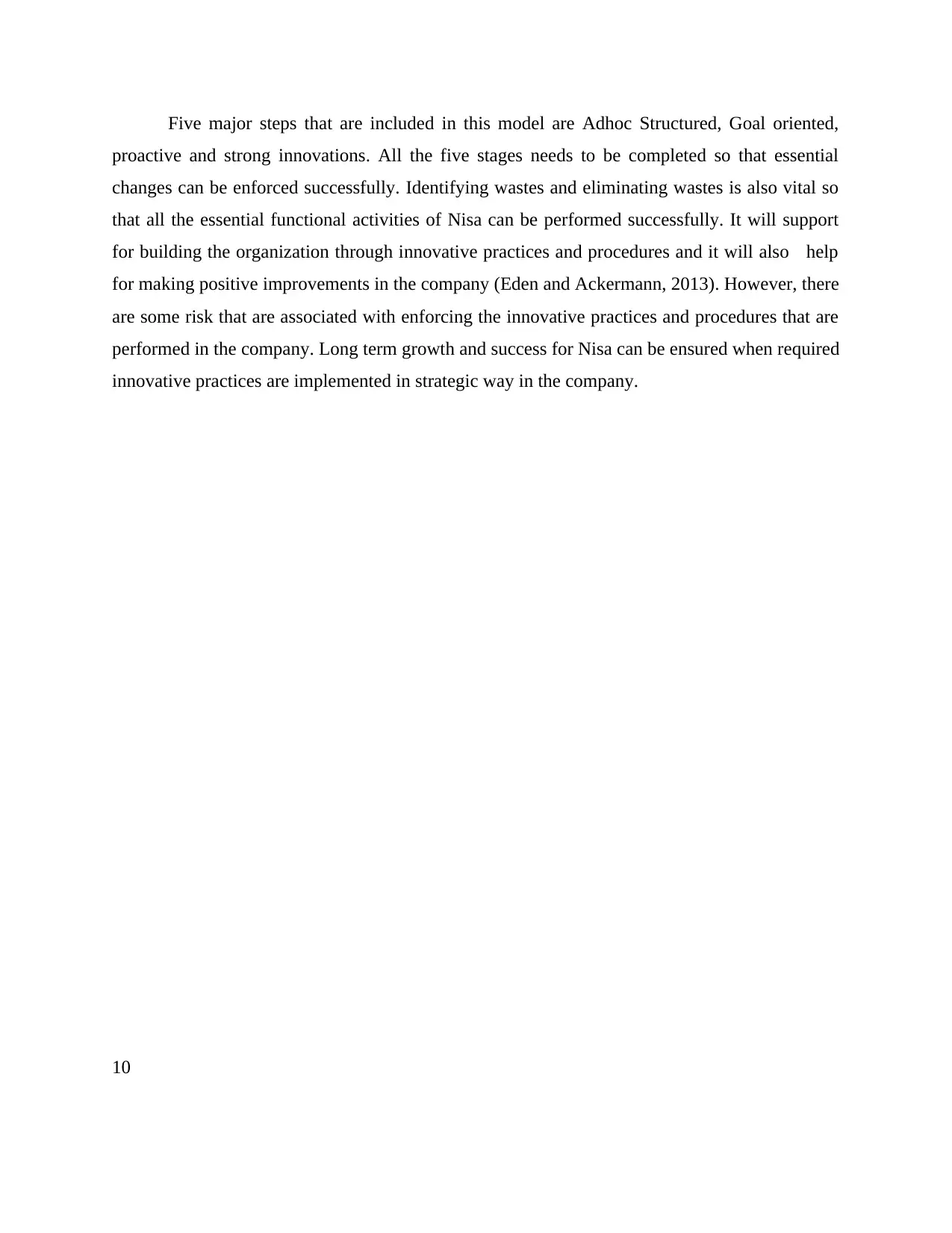
Five major steps that are included in this model are Adhoc Structured, Goal oriented,
proactive and strong innovations. All the five stages needs to be completed so that essential
changes can be enforced successfully. Identifying wastes and eliminating wastes is also vital so
that all the essential functional activities of Nisa can be performed successfully. It will support
for building the organization through innovative practices and procedures and it will also help
for making positive improvements in the company (Eden and Ackermann, 2013). However, there
are some risk that are associated with enforcing the innovative practices and procedures that are
performed in the company. Long term growth and success for Nisa can be ensured when required
innovative practices are implemented in strategic way in the company.
10
proactive and strong innovations. All the five stages needs to be completed so that essential
changes can be enforced successfully. Identifying wastes and eliminating wastes is also vital so
that all the essential functional activities of Nisa can be performed successfully. It will support
for building the organization through innovative practices and procedures and it will also help
for making positive improvements in the company (Eden and Ackermann, 2013). However, there
are some risk that are associated with enforcing the innovative practices and procedures that are
performed in the company. Long term growth and success for Nisa can be ensured when required
innovative practices are implemented in strategic way in the company.
10
Paraphrase This Document
Need a fresh take? Get an instant paraphrase of this document with our AI Paraphraser
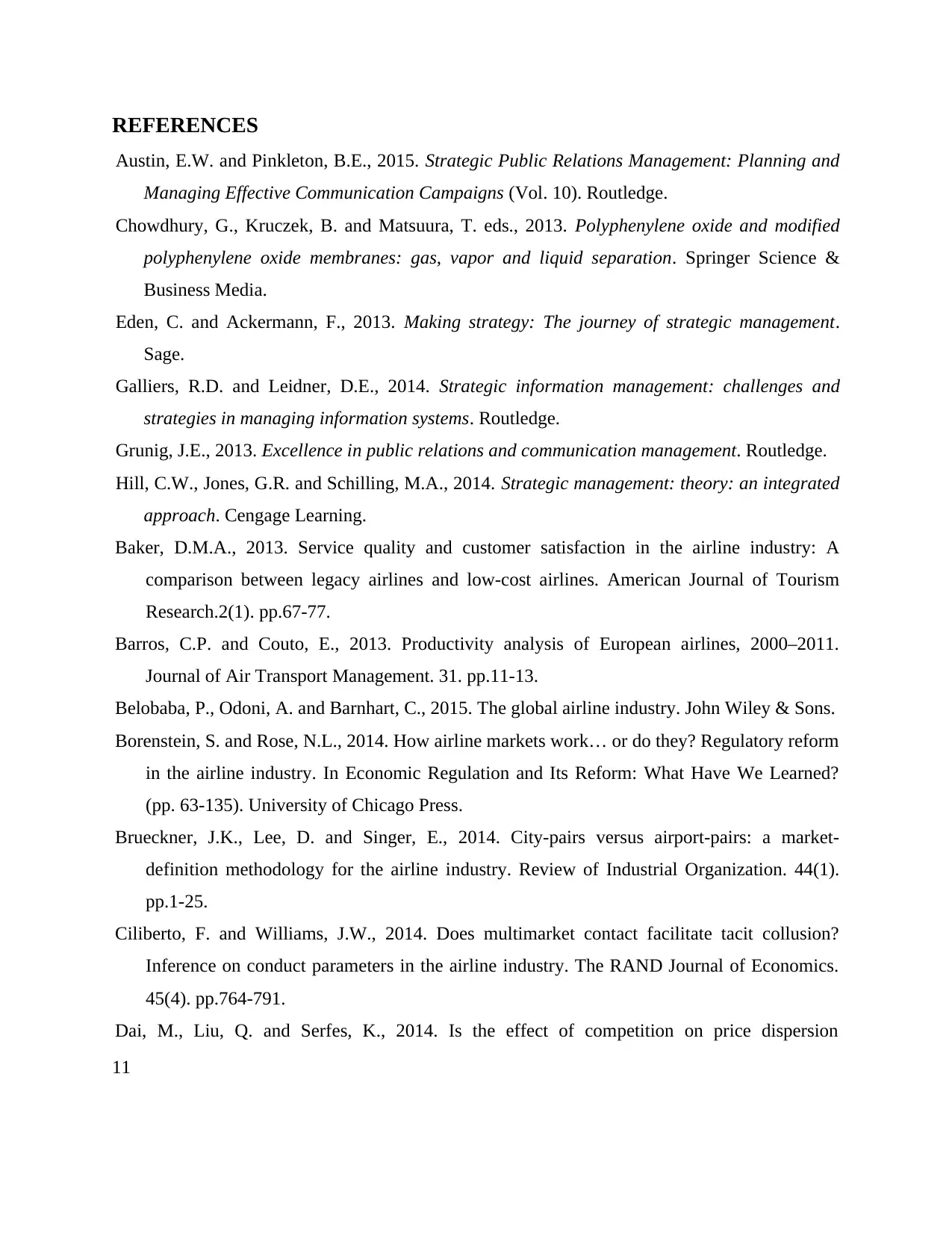
REFERENCES
Austin, E.W. and Pinkleton, B.E., 2015. Strategic Public Relations Management: Planning and
Managing Effective Communication Campaigns (Vol. 10). Routledge.
Chowdhury, G., Kruczek, B. and Matsuura, T. eds., 2013. Polyphenylene oxide and modified
polyphenylene oxide membranes: gas, vapor and liquid separation. Springer Science &
Business Media.
Eden, C. and Ackermann, F., 2013. Making strategy: The journey of strategic management.
Sage.
Galliers, R.D. and Leidner, D.E., 2014. Strategic information management: challenges and
strategies in managing information systems. Routledge.
Grunig, J.E., 2013. Excellence in public relations and communication management. Routledge.
Hill, C.W., Jones, G.R. and Schilling, M.A., 2014. Strategic management: theory: an integrated
approach. Cengage Learning.
Baker, D.M.A., 2013. Service quality and customer satisfaction in the airline industry: A
comparison between legacy airlines and low-cost airlines. American Journal of Tourism
Research.2(1). pp.67-77.
Barros, C.P. and Couto, E., 2013. Productivity analysis of European airlines, 2000–2011.
Journal of Air Transport Management. 31. pp.11-13.
Belobaba, P., Odoni, A. and Barnhart, C., 2015. The global airline industry. John Wiley & Sons.
Borenstein, S. and Rose, N.L., 2014. How airline markets work… or do they? Regulatory reform
in the airline industry. In Economic Regulation and Its Reform: What Have We Learned?
(pp. 63-135). University of Chicago Press.
Brueckner, J.K., Lee, D. and Singer, E., 2014. City-pairs versus airport-pairs: a market-
definition methodology for the airline industry. Review of Industrial Organization. 44(1).
pp.1-25.
Ciliberto, F. and Williams, J.W., 2014. Does multimarket contact facilitate tacit collusion?
Inference on conduct parameters in the airline industry. The RAND Journal of Economics.
45(4). pp.764-791.
Dai, M., Liu, Q. and Serfes, K., 2014. Is the effect of competition on price dispersion
11
Austin, E.W. and Pinkleton, B.E., 2015. Strategic Public Relations Management: Planning and
Managing Effective Communication Campaigns (Vol. 10). Routledge.
Chowdhury, G., Kruczek, B. and Matsuura, T. eds., 2013. Polyphenylene oxide and modified
polyphenylene oxide membranes: gas, vapor and liquid separation. Springer Science &
Business Media.
Eden, C. and Ackermann, F., 2013. Making strategy: The journey of strategic management.
Sage.
Galliers, R.D. and Leidner, D.E., 2014. Strategic information management: challenges and
strategies in managing information systems. Routledge.
Grunig, J.E., 2013. Excellence in public relations and communication management. Routledge.
Hill, C.W., Jones, G.R. and Schilling, M.A., 2014. Strategic management: theory: an integrated
approach. Cengage Learning.
Baker, D.M.A., 2013. Service quality and customer satisfaction in the airline industry: A
comparison between legacy airlines and low-cost airlines. American Journal of Tourism
Research.2(1). pp.67-77.
Barros, C.P. and Couto, E., 2013. Productivity analysis of European airlines, 2000–2011.
Journal of Air Transport Management. 31. pp.11-13.
Belobaba, P., Odoni, A. and Barnhart, C., 2015. The global airline industry. John Wiley & Sons.
Borenstein, S. and Rose, N.L., 2014. How airline markets work… or do they? Regulatory reform
in the airline industry. In Economic Regulation and Its Reform: What Have We Learned?
(pp. 63-135). University of Chicago Press.
Brueckner, J.K., Lee, D. and Singer, E., 2014. City-pairs versus airport-pairs: a market-
definition methodology for the airline industry. Review of Industrial Organization. 44(1).
pp.1-25.
Ciliberto, F. and Williams, J.W., 2014. Does multimarket contact facilitate tacit collusion?
Inference on conduct parameters in the airline industry. The RAND Journal of Economics.
45(4). pp.764-791.
Dai, M., Liu, Q. and Serfes, K., 2014. Is the effect of competition on price dispersion
11
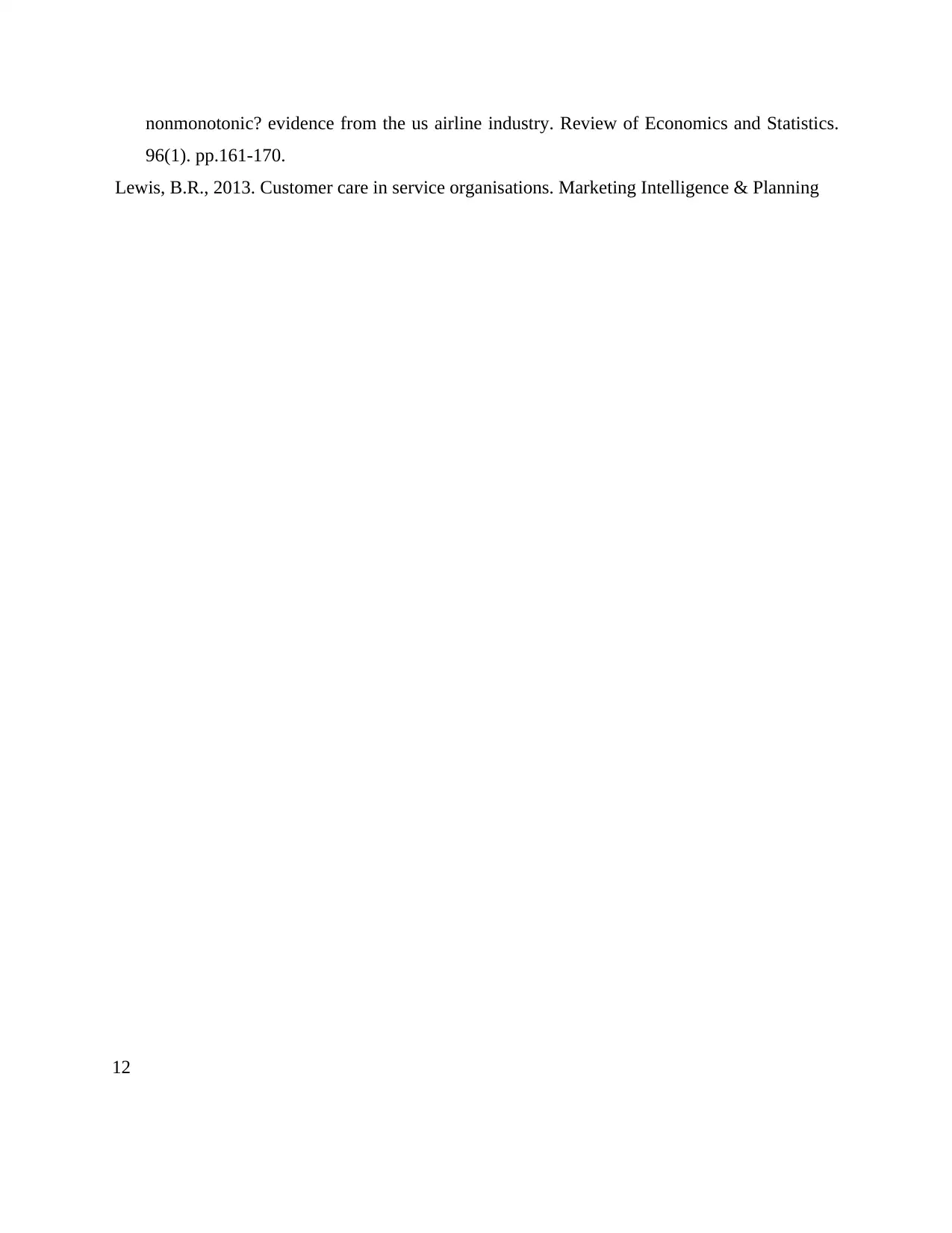
nonmonotonic? evidence from the us airline industry. Review of Economics and Statistics.
96(1). pp.161-170.
Lewis, B.R., 2013. Customer care in service organisations. Marketing Intelligence & Planning
12
96(1). pp.161-170.
Lewis, B.R., 2013. Customer care in service organisations. Marketing Intelligence & Planning
12
⊘ This is a preview!⊘
Do you want full access?
Subscribe today to unlock all pages.

Trusted by 1+ million students worldwide
1 out of 12
Related Documents
Your All-in-One AI-Powered Toolkit for Academic Success.
+13062052269
info@desklib.com
Available 24*7 on WhatsApp / Email
![[object Object]](/_next/static/media/star-bottom.7253800d.svg)
Unlock your academic potential
Copyright © 2020–2025 A2Z Services. All Rights Reserved. Developed and managed by ZUCOL.





